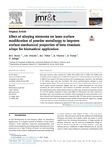Mostrar o rexistro simple do ítem
Effect of Alloying Elements on Laser Surface Modification of Powder Metallurgy to Improve Surface Mechanical Properties of Beta Titanium Alloys for Biomedical Application
| dc.contributor.author | Rossi, M. C. | |
| dc.contributor.author | Amado, José | |
| dc.contributor.author | Tobar, M. J. | |
| dc.contributor.author | Vicente-Escuder, Ángel | |
| dc.contributor.author | Yáñez, A. | |
| dc.contributor.author | Amigó, Vicente | |
| dc.date.accessioned | 2021-10-20T16:29:14Z | |
| dc.date.available | 2021-10-20T16:29:14Z | |
| dc.date.issued | 2021-09 | |
| dc.identifier.citation | M.C. Rossi, J.M. Amado, M.J. Tobar, A. Vicente, A. Yañez, V. Amigó, Effect of alloying elements on laser surface modification of powder metallurgy to improve surface mechanical properties of beta titanium alloys for biomedical application, Journal of Materials Research and Technology, Volume 14, 2021, Pages 1222-1234, ISSN 2238-7854, https://doi.org/10.1016/j.jmrt.2021.07.037. (https://www.sciencedirect.com/science/article/pii/S2238785421007006) | |
| dc.identifier.issn | 2238-7854 | |
| dc.identifier.uri | http://hdl.handle.net/2183/28684 | |
| dc.description.abstract | [Abstract] Beta-type titanium alloy surfaces (Tie35Nbe10Ta (TNT) and Tie30Nbe4Sn (TNS)) weremodified by laser using a power of 1000 W and speed of 6.7 mm/s (Condition A) and a powerof 1500 W with speed of 10 mm/s (Condition B). Increasing laser conditions, the thicknessof the molten layer was also increased. The initial equiaxed grains changes to quiteelongated grains shape. The surfaces were structured undera00martensite,aand matrixb.Thebphase content decreased slightly and thea00phase increased for both alloysincreasing the laser conditions. The condition A increased the elastic modulus (E) anddecreased the hardness while condition B did not affect the mechanical properties surfacefor the TNT system compared to base metal (BM). In TNS system the laser condition Adecreased the E and increased the hardness while increasing the laser parameters (Con-dition B) both E and hardness decreased compared to BM. The laser surface treatment wasinfluenced by the levels of alloying elements present promoting most significant changesin the microstructure and mechanical properties in the TNS system | es_ES |
| dc.description.sponsorship | This work was supported by the Ministerio Español de Ciencia, Innovación y Universidades, Spain with Grant RTI2018-097810-B-I00, RTI2018-096472-B-I00 and the European Union (EU) through Fondo Europeo de Desarrollo Regional (FEDER), Spain | es_ES |
| dc.language.iso | eng | es_ES |
| dc.publisher | Elsevier | es_ES |
| dc.relation | info:eu-repo/grantAgreement/AEI/Plan Estatal de Investigación Científica y Técnica y de Innovación 2017-2020/RTI2018-097810-B-I00/ES/BIOCOMPATIBILIDAD DE NUEVAS ALEACIONES PULVIMETALURGICAS DE TITANIO OBTENIDAS POR TECNOLOGIAS AVANZADAS/ | |
| dc.relation | info:eu-repo/grantAgreement/AEI/Plan Estatal de Investigación Científica y Técnica y de Innovación 2017-2020/RTI2018-096472-B-I00/ES/ESTABLECIMIENTO DE UNA METODOLOGIA PARA LA OBTENCION DE MATERIALES CON GRADIENTE DE CONCENTRACION BIDIMENSIONAL MEDIANTE LA DEPOSICION DIRECTA DE MATERIALES CON LASER/ | |
| dc.relation.uri | https://doi.org/10.1016/j.jmrt.2021.07.037 | es_ES |
| dc.rights | Atribución 4.0 Internacional | es_ES |
| dc.rights.uri | http://creativecommons.org/licenses/by/4.0/ | * |
| dc.subject | Mechanical properties | es_ES |
| dc.subject | Laser melting | es_ES |
| dc.subject | Microstructure | es_ES |
| dc.subject | Martensite | es_ES |
| dc.subject | Ti–35Nb–10Ta | |
| dc.subject | Ti–30Nb–4Sn | |
| dc.title | Effect of Alloying Elements on Laser Surface Modification of Powder Metallurgy to Improve Surface Mechanical Properties of Beta Titanium Alloys for Biomedical Application | es_ES |
| dc.type | info:eu-repo/semantics/article | es_ES |
| dc.rights.access | info:eu-repo/semantics/openAccess | es_ES |
| UDC.journalTitle | Journal of Materials Research and Technology | es_ES |
| UDC.volume | 14 | es_ES |
| UDC.startPage | 1222 | es_ES |
| UDC.endPage | 1234 | es_ES |
| dc.identifier.doi | 10.1016/j.jmrt.2021.07.037 |
Ficheiros no ítem
Este ítem aparece na(s) seguinte(s) colección(s)
-
CIT-LAIL - Artigos [31]






